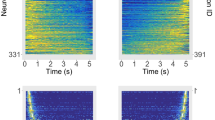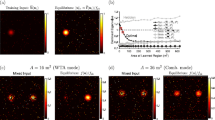Abstract
The single-layer continuous attractor neural network (CANN) model has been applied successfully to describe the tracking of moving stimuli of a single modality. Experimental evidence shows that stimuli of different modalities interact with each other in the neural system. To study these interaction effects, we generalize the single-module structure to a bimodular one. We found that when there is one static stimulus in one module and a moving one in the other, the network have very different behaviours depending on whether the inter-modular couplings are excitatory or inhibitory. We further compare the model with experimental observations that illustrate the interactions between two sensory modalities, such as the motion-bounce Illusion. Agreement between model and experimental results can be obtained for appropriate choice of parameters.
Access this chapter
Tax calculation will be finalised at checkout
Purchases are for personal use only
Similar content being viewed by others
References
Camperi, M., Wang, X.J.: A model of visuospatial working memory in prefrontal cortex: recurrent network and cellular bistability. J. Comput. Neurosci. 5(4), 383–405 (1998)
Wu, S., Hamaguchi, K., Amari, S.I.: Dynamics and computation of continuous attractors. Neural Comput. 20(4), 994–1025 (2008)
Fung, C.C.A., Wong, K.Y.M., Wu, S.: A moving bump in a continuous manifold: a comprehensive study of the tracking dynamics of continuous attractor neural networks. Neural Comput. 22(3), 752–792 (2010)
Fung, C.C.A., Wong, K.Y.M., Wang, H., Wu, S.: Dynamical synapses enhance neural information processing: gracefulness, accuracy, and mobility. Neural Comput. 24(5), 1147–1185 (2012)
Zhou, C.S., Zemanov, L., Zamora, G., Hilgetag, C.C., Kurths, J.: Hierarchical organization unveiled by functional connectivity in complex brain networks. Phys. Rev. Lett. 97(23), 238103 (2006)
Zhang, W.H., Chen, A., Rasch, M.J., Wu, S.: Decentralized multisensory information integration in neural systems. J. Neurosci. 36(2), 532–547 (2016)
Watanabe, K.: Crossmodal interaction in humans. Doctoral dissertation, California Institute of Technology (2001)
Shimojo, S., Shams, L.: Sensory modalities are not separate modalities: plasticity and interactions. Curr. Opin. Neurobiol. 11(4), 505–509 (2001)
Watkins, S., Shams, L., Tanaka, S., Haynes, J.D., Rees, G.: Sound alters activity in human V1 in association with illusory visual perception. Neuroimage 31(3), 1247–1256 (2006)
Sekuler, R., Sekuler, A.B., Lau, R.: Sound alters visual motion perception. Nature 385(6614), 308 (1997)
Jaekl, P.M., Harris, L.R.: Auditoryvisual temporal integration measured by shifts in perceived temporal location. Neurosci. Lett. 417(3), 219–224 (2007)
Zhang, W.H., Wu, S.: Neural information processing with feedback modulations. Neural Comput. 24(7), 1695–1721 (2012)
Ernst, M.O., Banks, M.S.: Humans integrate visual and haptic information in a statistically optimal fashion. Nature 415(6870), 429–433 (2002)
Zhang, W.H., Chen, A., Rasch, M.J., Wu, S.: Decentralized multisensory information integration in neural systems. J. Neurosci. 36(2), 532–547 (2016)
Shams, L., Seitz, A.R.: Benefits of multisensory learning. Trends Cogn. Sci. 12(11), 411–417 (2008)
Gu, Y., Angelaki, D.E., DeAngelis, G.C.: Neural correlates of multisensory cue integration in macaque MSTd. Nat. Neurosci. 11(10), 1201–1210 (2008)
Molholm, S., Ritter, W., Javitt, D.C., Foxe, J.J.: Multisensory visualauditory object recognition in humans: a high-density electrical mapping study. Cereb. Cortex 14(4), 452–465 (2004)
Fetsch, C.R., Pouget, A., DeAngelis, G.C., Angelaki, D.E.: Neural correlates of reliability-based cue weighting during multisensory integration. Nat. Neurosci. 15(1), 146–154 (2012)
Hairston, W.D., Wallace, M.T., Vaughan, J.W., Stein, B.E., Norris, J.L., Schirillo, J.A.: Visual localization ability influences cross-modal bias. J. Cogn. Neurosci. 15(1), 20–29 (2003)
Seitz, A.R., Kim, R., Shams, L.: Sound facilitates visual learning. Curr. Biol. 16(14), 1422–1427 (2006)
Odegaard, B., Wozny, D.R., Shams, L.: The effects of selective and divided attention on sensory precision and integration. Neurosci. Lett. 614, 24–28 (2016)
Carandini, M., Heeger, D.J.: Normalization as a canonical neural computation. Nat. Rev. Neurosci. 13(1), 51–62 (2012)
Stanford, T.R., Quessy, S., Stein, B.E.: Evaluating the operations underlying multisensory integration in the cat superior colliculus. J. Neurosci. 25(28), 6499–6508 (2005)
Driver, J., Noesselt, T.: Multisensory interplay reveals crossmodal influences on sensory-specificbrain regions, neural responses, and judgments. Neuron 57(1), 11–23 (2008)
Kim, R.S., Seitz, A.R., Shams, L.: Benefits of stimulus congruency for multisensory facilitation of visual learning. PLoS One 3(1), e1532 (2008)
Zhang, W.H., Wang, H., Wong, K.T.M., Wu, S.: Congruent and opposite neurons: sisters for multisensory integration and segregation. In: Advances in Neural Information Processing Systems, pp. 3180–3188 (2016)
Wang, H., Zhang, W.-H., Wong, K.Y.M., Wu, S.: How the prior information shapes neural networks for optimal multisensory integration. In: Cong, F., Leung, A., Wei, Q. (eds.) ISNN 2017. LNCS, vol. 10262, pp. 128–136. Springer, Cham (2017). doi:10.1007/978-3-319-59081-3_16
Acknowledgments
This work is supported by grants from the Research Grants Council of Hong Kong (grant numbers N_HKUST606/12, 605813 and 16322616).
Author information
Authors and Affiliations
Corresponding author
Editor information
Editors and Affiliations
Rights and permissions
Copyright information
© 2017 Springer International Publishing AG
About this paper
Cite this paper
Yan, M., Zhang, WH., Wang, H., Wong, K.Y.M. (2017). The Dynamics of Bimodular Continuous Attractor Neural Networks with Moving Stimuli. In: Liu, D., Xie, S., Li, Y., Zhao, D., El-Alfy, ES. (eds) Neural Information Processing. ICONIP 2017. Lecture Notes in Computer Science(), vol 10637. Springer, Cham. https://doi.org/10.1007/978-3-319-70093-9_69
Download citation
DOI: https://doi.org/10.1007/978-3-319-70093-9_69
Published:
Publisher Name: Springer, Cham
Print ISBN: 978-3-319-70092-2
Online ISBN: 978-3-319-70093-9
eBook Packages: Computer ScienceComputer Science (R0)




